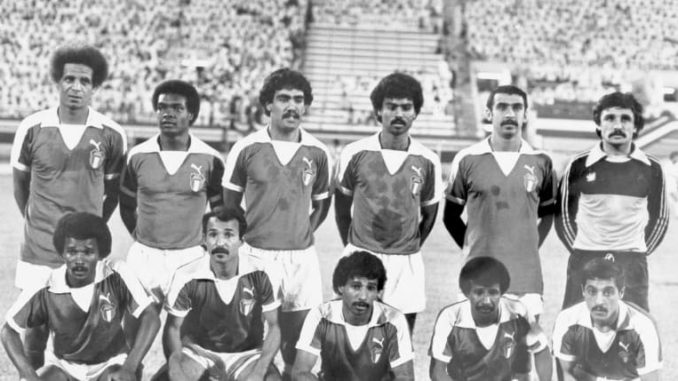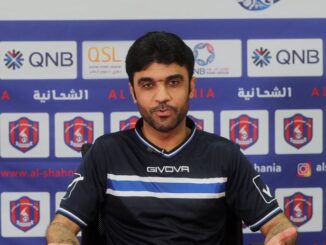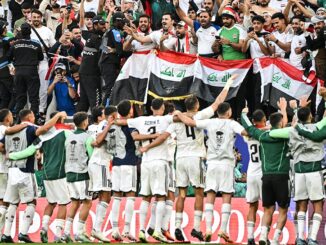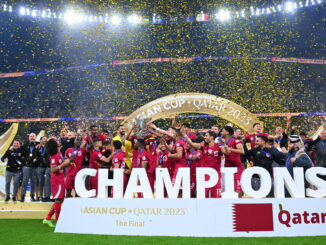
The greatest ever Gulf Cup?
Veteran watchers of this most regional, beloved tournament will tell you it was in Qatar.
No. Not the 2019 Gulf Cup, nevermind that it proved historic with Bahrain claiming their first ever crown.
For many, the greatest Gulf Cup, no doubt seen through the haze of nostalgia, was, and always will be, Qatar 1976.
It was only the fourth edition of the competition, a time when the Gulf Cup stood for far more than it seemingly does for now. The, initially at least, bi-annual tournament was eagerly anticipated in a way that participating nations now reserve for AFC Asian Cups or World Cup qualifiers.
It was not only an opportunity at winning bragging rights over neighbours. It was, quite simply, a chance at winning anything.
The tournament might not have been a FIFA sanctioned competition but it was one that for a long time held a lot of significance for the teams that took part in it.
The 1976 Gulf Cup was the first to welcome seven teams, Iraq having joined the six nations that would go on to form the Gulf Cooperation Council (GCC); Kuwait, Saudi Arabia, Qatar, United Arab Emirates, Oman and Bahrain.
Seven teams, 23 matches, and 84 goals in 17 memorable days. But in reality, the 1976 Gulf Cup was about two teams. Or, to be precise, two matches. Two matches that would usher arguably the Gulf’s greatest ever football rivalry.
The previous three Gulf Cup has been tournaments in name only, proving to be nothing but a procession for Kuwait.
Saudi Arabia, UAE, Bahrain, Oman and Qatar, all relatively young nations, were still at least a decade from having teams that could be considered anywhere near competitive at international level. Kuwait stood alone as the Gulf’s leading football nation.
Then along came Iraq.
And the 1976 Gulf Cup, back in the days of two points for a win, would prove to be the arguably the competition’s greatest edition to this day.
In Kuwait’s blue corner: Lebanese-born goalkeeper Ahmad Tarabulsi, goal machine Jassem Yaqoub, midfield maestros Abdulaziz Al Anbari, and Hamad Abu Hamad, the lanky, elusive Fathi Kameel, and the golden boy Faisal Al Dakheel.
With Brazilian legend Mario Zagallo at the helm, Al Azraq (The Blue) played football well ahead of their time, at least in the region. Adored by an an enthralled nation, the players were – and would go on to a greater extent in the future – to transcend football, becoming celebrities in the Gulf and the Arab world.
In the green corner, Iraq were perhaps a more of an unknown quantity, though not to their fans. They were about unleash a cultural explosion of their own on the region.
Managed by the Scotsman Danny McLennan they boasted their own roster of gifted players; Raad Hammoudi in goal, flying left-winger Ali Kadhim, box-to-box midfielder Hadi Ahmed, Nigem Al Fartooss, Sabah Abdulghalil; and finally the legendary goalscorer Falah Hassan, who went by the tag of “Seeler” for his resemblance to West German international Uwe Seeler.
If some fans still did not know what to expect from the new men in green at the start of the tournament, they certainly did by the end of it. Iraq’s introduction to the mix proved a seismic event.
They introduced themselves to the Gulf Cup (with a round robin format) with a 4-0 win over Oman on the first day, on which the hosts had beaten Saudi Arabia 1-0 in the tournament opener.
This was a Saudi Arabia team that bore no resemblance to the one that, remarkably, only eight years later would be crowned AFC Asian Cup winner.
Kuwait, unsurprisingly, responded with equal brutality two days later, ensuring any optimism the hosts had engendered with an opening day win was put in firm context. Another 4-0 win, and Iraq and Kuwait shared the early lead of the the table. But it was brief parity.
That night the Iraqis destroyed Bahrain 4-1, Hassan and Kadhim among the scorers again.
Kuwait had two days to formulate a response. When it came, on March 21, it was as eloquent as it was devastating. An 8-0 win over a scarred Oman, in which Yaqoub scored four and Al Dakheel two, remains the competition’s record win.
Hours later Iraq showed that anything their rivals can do, they can do just as well with 7-1 (Kadhim hat-trick) walk in the park against Saudi Arabia.
The two teams were pushing each other to greater heights.
The looming clash between the two team with 100 percent records was already shaping up to be a virtual final. As if to take a breather from their goal-heavy efforts, both teams recorded scoreless draws in their following matches on April 1; Iraq with Qatar, Kuwait with UAE.
Elsewhere Qatar were proving to be the best of the rest, having beaten the UAE 3-1 and Oman 4-1. Against the latter, a 21-year-old by the name of Mansour Muftah scored twice; by the end of the competition he had notched four goals and he would go on to become Qatar’s greatest ever player.
At least that kept the home crowds happy. As did the seemingly unstoppable deluge of goals, at least from the big two.
The next round of matches saw Kuwait beat Bahrain 5-2, with Iraq responding with a 4-0 thrashing of UAE.
Iraq led the table having played, and won, an extra match.
And so to the big day, April 5, 1976. It was a final in all but name.
Kuwait vs Iraq. Zagallo v McLennan. Yaqoub, Al Anbari, Al Dakheel vs Hassan, Kadhim and Sobhi. Tarbulsi vs Hamoudi. The match would kick off a long and ultimately bitter, niggly rivalry over the next decade.
Kuwait where about to face an opponent of a calibre they had never before in the Gulf Cup. The four and five goal drubbings liberally handed out to hapless opponents were coming to a halt.
The Kuwaitis quickly realised this, with Iraq dominating long stretches of the first half.
Watching the footage today, it is remarkable just how advanced the football on display was. There was no plodding, slow build ups you might associate with an emerging footballing region, and in many passages of play, the intensity and skill shown by the Iraqis easily trumps many modern teams in the region.
In particular, Kadhim’s close control and pace down the left channels was a delight, his crosses invariably finding the head of Hassan, who had a magnificent ability to hang in the air that split second longer than his opponents.
Tarabulsi in Kuwait’s goal, as he needed to be, was superb.
That all changed after half time as Iraq quickly took a two goal lead thanks to strikes by Sabah Abdulghalil and Kadhim. Kuwait were shaken, but stung into action. Yaqoub pulled one back on 55 minutes, and Al Dakheel equalised with a close-range header a minute later.
It had been a remarkable opening to the second half, but there would be no more goals.
The 2-2 draw meant that Kuwait, having played one match less, needed to beat Saudi Arabia two days later to force a play-off match to determine the champion. They did that with another comfortable 3-1 win with two goals from Al Dakheel and one from the unstoppable Yaqoub.
Kuwait and Iraq finished equal on points, both with a goal difference of +17. Between them they had scored 41 goals, while the other five teams had only managed a combined 36.
It all came down to a winner-takes-all face off, and it produced the most famous match in Gulf Cup history.
Al Anbari, a bundle of energy, scored after only eight minutes to give Kuwait a lead that was cancelled out only a minute later by Ahmad.
On 25 minutes, Al Anbari, having the match of his life, scored again and just before half time Yaqoub bent an exquisite left-footed free-kick beyond Hamoudi to give Kuwait what looked like a deceive lead.
But as this fixture would go on to show in the coming years, the story was from over.
Sobhi scored again to halve Kuwait’s lead and Iraq threw everything at their opponents who could sensed a fourth Gulf Cup nearing.
And then, the coup de grâce.
Well into injury time, Iraq had one last lifeline, a free kick to the left of the Kuwaiti penalty box. The ball was clipped long, and Tarabulsi rose to punch the ball. What happened next prompted one of the Gulf Cup’s greatest commentaries, by Kuwait’s legendary Khaled Al Harban.
“Tarabulsi clears. Faisal Al Dakheel to Al Anbari … goal!”
But the ball had barely crossed the halfway line at that point.
“Anbari, Anbari, Anbari, go Anbari,” he urged as the Kuwaiti number 10 bore down on Hamoudi.
Brilliantly, having run the length of the field, Al Anbari deftly lofted the ball over the Iraqi keeper.
“Goal, goal, goal, goal, Allahu Akbar, Allahu Akbar,” Al Harban cried.
“Kuwait are Gulf Cup champions.”
It was a perfect end to a wonderful tournament.
Yaqoub grabbed the Golden Boot with nine goals, while Kadhim was voted the tournament’s best player.
The Gulf Cup would go on to have its ups and downs in the following four decades. And so would Iraq and Kuwait, for many reasons, many of them not related to football.
The other nations would all catch up, and overtake them, at some point or another. Qatar, having held the latest Gulf Cup, now looks forward to the biggest prize of all; hosting the 2022 World Cup.
Football in the Gulf has come a long way. But it was never so fresh, pure and exiting as it was in those spring days of 1976.




